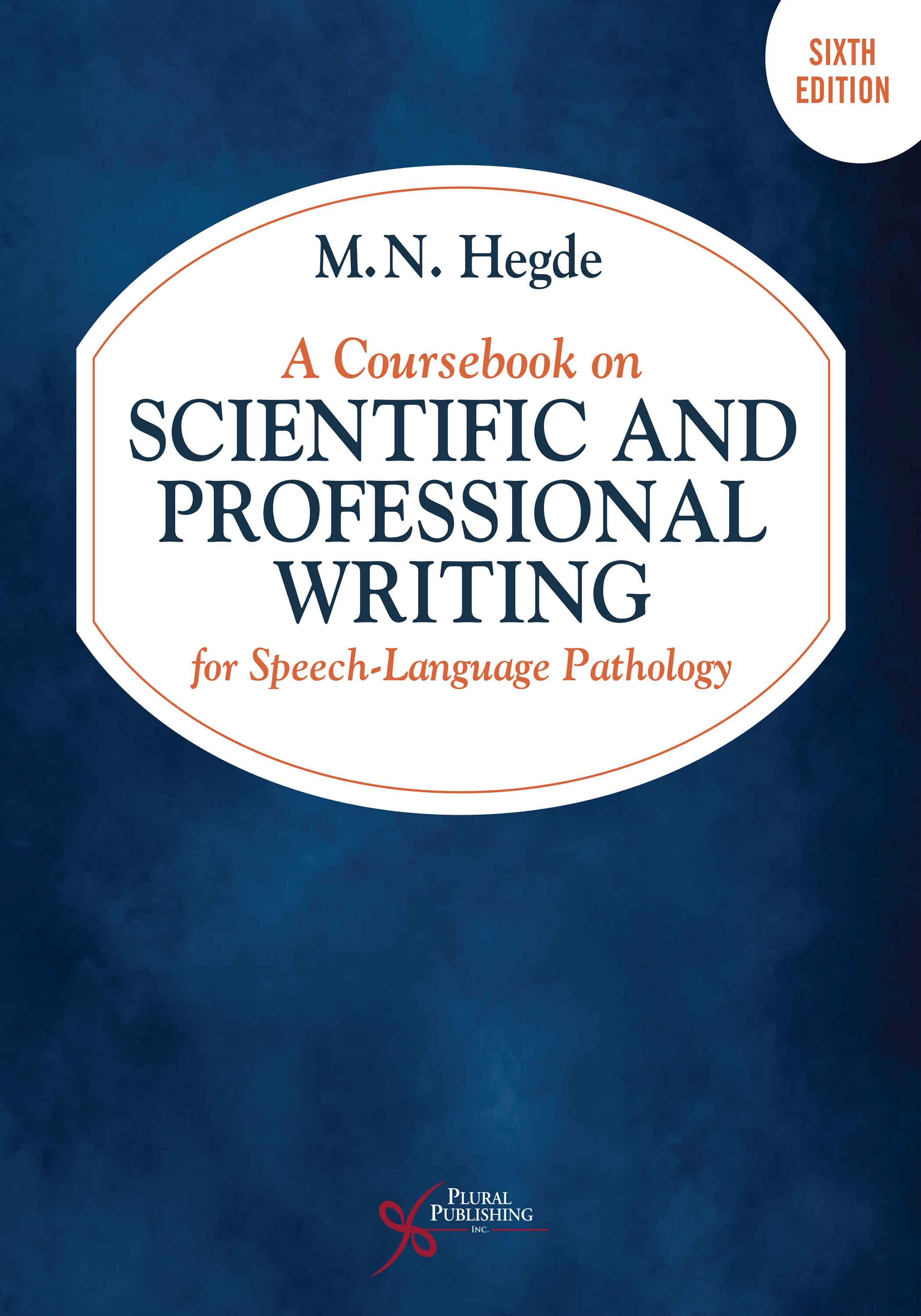
A Coursebook on Scientific and Professional Writing for Speech-Language Pathology
Sixth Edition
M.N. Hegde
Details: 459 pages, B&W, Spiral, 8.5" x 11"
ISBN13: 978-1-63550-401-9
© 2024 | Available
For Instructors
Purchase
The only book that covers both scientific and clinical writing skills
for the field of speech-language pathology!
The only printed book on which the students can practice writing!
A Coursebook on Scientific and Professional Writing for Speech-Language Pathology, Sixth Edition is a unique interactive resource to help students develop the strong writing skills necessary for a successful clinical or academic career in speech-language pathology. The book not only describes the principles of good writing, but also contains numerous opportunities to practice writing skills replete with exemplars. The Coursebook is ideal for dedicated courses on scientific and/or professional writing, and can also be used in courses on assessment, research methods, and clinical methods and practicum.
The first section of the book is a refresher on the basic rules of grammar, punctuation, and composition. The second section is focused on scientific writing and explains the different types of academic publications, offers tips on how to write without bias, and describes the typical manuscript formatting required for scientific publications. It also includes examples of the “elements of scientific style,” such as capitalization and abbreviations, how to reference sources cited within the text, and how to prepare the reference list. Also covered are how to submit a manuscript to scholarly journals and best practices for proofreading and making revisions. The last section is focused on professional/clinical writing and the various written communications speech-language pathologists (SLPs) prepare as part of their jobs. These include diagnostic reports, brief and comprehensive treatment plans, and progress reports. The book ends with a section on report writing for SLPs working in public schools, including assessment reports, IEPs, and SOAP notes.
A unique and student-friendly feature of the book is its practical design. The first two sections provide incorrect exemplars the user can rewrite or write correctly. In the last section, left-hand pages show specific examples of general, scientific, or professional writing, and the corresponding right-hand pages allow students to practice writing.
Updates to the Scientific Writing section include:
The text incorporates APA 7th edition changes to reference citations and preparation of the reference list, along with updates on how to cite electronic sources. The bias-free writing section is updated and expanded to include appropriate terms and writing style to describe LGBTQ community members. A glossary is provided for easy reference. Information on how to submit content to academic journals and conferences, preparing electronic manuscripts, and making revisions in light of the copyeditor’s comments have been updated to current publishing industry standards.
Updates to the Professional Writing section include:
The text includes current clinical terminology and practice in speech-language pathology. A new trial-by-trial treatment progress recording sheet has been added to the progress report section. A subjective, objective, assessment, plan (SOAP) progress report written for medical settings has been added, along with a new section on report writing in public schools, which includes an assessment plan that helps determine whether a student meets the school district’s criteria for enrollment in clinical speech-language services.
Review
“…The purpose of the book is to prepare speech-language pathology students for both academic and clinical writing tasks required within the field. Intended as a coursebook, the book includes examples of edited writing with correct and incorrect examples and writing assignments for each skill. It is a unique resource as it teaches grammatical and writing conventions within the context of speech-language pathology and can be used in both clinical and academic courses…
The book is intended for speech-language pathology students and is beneficial for both graduate and undergraduate cohorts. It could also be helpful for professionals who struggle with written language. It is a valuable text for speech-language pathology professors because it is written didactically with examples, exercises, and space for notetaking…
The book is organized into three sections: writing foundations, scientific writing, and professional writing. The writing foundations portion teaches basic grammatical forms such as plurals vs. possessives and subject-verb agreement, using content relevant to speech-language pathology students. Each grammatical lesson has an example page and an adjacent page with practice exercises. The book progresses to teach students how to structure and compose essays and research papers…
This book is unique and useful for students as it comprehensively combines academic and clinical subject matter with lessons on grammar and writing conventions…”
– Suzanne M Welty, MA, EdD, CCC, Biola University, from Doody’s Reviews (Spring 2023)
Preface to the Sixth Edition
Acknowledgements
About the Author
PART A
FOUNDATIONS OF SCIENTIFIC AND PROFESSIONAL WRITING
A.1. BASIC RULES OF USAGE
Ampersand
A.1.1. Use the Ampersand Correctly
Apostrophe
A.1.2. Do Not Turn a Possessive Into a Plural
A.1.3. Do Not Turn a Plural Into a Possessive
A.1.4. Use the Correct Forms of Possessive Nouns
A.1.5. Use the Possessive Forms of Pronouns Correctly
A.1.6. Distinguish Contractions From Possessives
Unusual Singulars and Plurals
A.1.7. Use Unusual Singulars and Plurals Correctly
Comma
A.1.8. Use a Serial Comma
A.1.9. Do Not Use a Serial Comma When You Write Only Two Parallel Terms and
Connect Them With a Conjunction
A.1.10. Use a Comma to Separate Parenthetic Expressions That Are Not in Parentheses
A.1.11. Place a Comma Before a Conjunction Introducing an Independent Clause
A.1.12. Do Not Use a Comma Before a Conjunction That Is Followed by a Dependent Clause
Dash
A.1.13. Prefer an Em Dash to a Comma to Set Off an Abrupt Break
Semicolon
A.1.14. Join Independent Clauses With a Semicolon When the Clauses Are Not Joined by a Conjunction
Agreement
A.1.15. Follow the Rules of Agreement
Modifiers
A.1.16. Use Modifiers Correctly
Pronouns
A.1.17. Clarify the Referents of Pronouns
A.1.18. Let the Pronoun Agree in Number With Its Antecedent
A.1.19. Use the Proper Case of Pronoun
Sentence Fragments
A.1.20. Do Not Break a Single Sentence Into Two Parts
A.1.21. Do Not Write Sentence Fragments as a Series of Declarative Statements
A.1.22. Do Not Punctuate Appositives
Nouns and Adjectives
A.1.23. Use Certain Terms Only in Their Adjectival Forms
A.1.24. Do Not Turn a Noun Into a Verb
Participial Phrase
A.1.25. Let a Participial Phrase at the Beginning of a Sentence Refer to the Grammatical Subject
A.2 BASIC RULES OF COMPOSITION
Structure of Research Papers
A.2.1. Design a Broad Outline of Your Paper
A.2.2. Design Headings and Subheadings of Your Paper
Composing Paragraphs
A.2.3. Write Paragraphs That Express Related Ideas
A.2.4. Do Not Write Paragraphs That Are Too Long
A.2.5. Do Not Write One-Sentence Paragraphs
A.2.6. Begin and End Most Paragraphs With Transitionary Sentences
Concise and Direct Writing
A.2.7. Prefer the Shorter to the Longer Sentences
A.2.8. Prefer the Active Voice
A.2.9. Say What It Is, Instead of What It Is Not
A.2.10. Avoid Too Many Qualifications
A.2.11. Use Definite, Specific, and Concrete Language
A.2.12. Eliminate or Replace Unnecessary Phrases
A.2.13. Avoid Redundant Phrases
A.2.14. Avoid Wordiness
A.2.15. Avoid Jargon
A.2.16. Avoid Euphemism
A.2.17. Keep Related Words Together
Parallelism
A.2.18. Write in Parallel Terms
A.2.19. Maintain Parallelism in Numbered or Bulleted Lists
Misplaced or Dangling Modifiers
A.2.20. Avoid Dangling Modifiers
A.2.21. Avoid Misplaced Modifiers
Shifts Within and Between Sentences
A.2.22. Avoid Shifts Within and Between Sentences
Quotations
A.2.23. Make Quotations Count
A.2.24. Do Not Overuse Quotations
A.2.25. Do Not Include Islands of Quotations
A.2.26. Do Not Begin a Sentence With a Quotation
A.2.27. Use Quotation and Punctuation Marks Correctly
A.2.28. Do Not Misuse Quotation Marks
A.2.29. Give References for All Direct Quotations
A.2.30. Reproduce Quotations Exactly
A.2.31. Integrate Quotations of Fewer Than 40 Words With the Text
A.2.32. Arrange Quotations as a Block When They Have 40 Words or More
A.2.33. Show Correctly the Changes in Quotations
A.2.34. Quote Correctly the Sources on the Internet
Precision in the Use of Scientific Terms
A.2.35. Use the Terms Ending in -ology Correctly
A.2.36. Use Certain Terms Ending in -ics Correctly
Use of Fresh Language
A.2.37. Avoid Clichés
A.2.38. Avoid Colloquial or Informal Expressions
A.3. COMMONLY MISUSED WORDS AND PHRASES
A.3.1. Accept and Except
A.3.2. Affect and Effect
A.3.3. Alternate and Alternative
A.3.4. Allusion and Illusion
A.3.5. And/Or
A.3.6. Baseline and Baserate
A.3.7. Effect and Impact
A.3.8. Elicit and Evoke
A.3.9. Elicit and Illicit
A.3.10. Farther and Further
A.3.11. Focus and Analysis
A.3.12. Incidence and Prevalence
A.3.13. Inter- and Intra-
A.3.14. Latter and Later
A.3.15. Proof and Support
A.3.16. Secondly and Thirdly
A.3.17. Since and Because
A.3.18. There and Their
PART B
SCIENTIFIC WRITING
B.1. INTRODUCTION TO SCIENTIFIC WRITING
B.2. TERMS FOR WRITING WITHOUT BIAS
B.2.1. Do Not Overuse the Pronouns He and He or She
B.2.2. Use the Appropriate Terms of Gender Identities
B.2.3. Use the Appropriate Terms of Sexual Orientations
B.2.4. Avoid Prejudicial Reference to Disabilities
B.2.5. Avoid Prejudicial Reference to Ethnic or Racial Identity
B.2.6. Avoid Prejudicial Reference to Age
B.2.7. Avoid Prejudicial Comparisons of Study Groups
B.3. FORMAT OF SCIENTIFIC WRITING
Margins
B.3.1. Leave Correct Margins
Title Page
B.3.2. Type Correctly the Title Page of a Paper for Publication
B.3.3. Type Correctly the Title Page of a Class (Term) Paper
Running Head
B.3.4. Type the Manuscript Running Head Correctly
Abstract
B.3.5. Write an Abstract on the Second Page
Beginning of Text
B.3.6. Begin the Text With an Untitled Introductory Section on Page Three
Heading Levels
B.3.7. Use the Headings Within the Text Consistently
Font and Font Size
B.3.8. Use Acceptable Font and Size
B.3.9. Use Bold Font Correctly
Page Numbers
B.3.10. Number the Pages Correctly
B.3.11. Reprint the Corrected Pages
Line Spacing and Line Length
B.3.12. Use Appropriate Line Spacing
B.3.13. Align the Text to the Left Margin
B.3.14. Correct the Spelling Errors
B.4. ELEMENTS OF SCIENTIFIC STYLE
Capitalization
B.4.1. Capitalize the First Words
B.4.2. Capitalize the First and the Major Words
B.4.3. Capitalize the Words Correctly in Headings
B.4.4. Capitalize Proper Nouns and Trade Names
B.4.5. Capitalize the Chapters and Sections the Reader Is Referred To
B.4.6. Capitalize Nouns That Are Followed by a Number or Letter
B.4.7. Capitalize Both Words in Otherwise Capitalized Hyphenated Compound
B.4.8. Do Not Capitalize the Second Word of a Hyphenated Compound in Reference Lists
Italicization
B.4.9. Use Italics Correctly Within the Body of Text
B.4.10. Use Reverse Italics Correctly
B.4.11. Use Italics Correctly in the Reference List
Hyphenation
B.4.12. Use the Hyphen Correctly
B.4.13. Do Not Overuse or Misuse the Hyphen
Indentation
B.4.14. Use Correct Indentation
Space After Punctuation
B.4.15. Give Correct Space or No Space After Punctuation
Abbreviations
B.4.16. Write Out Abbreviations the First Time You Use the Term, and Enclose the Abbreviations in Parentheses
B.4.17. Do Not Start a Sentence With a Lowercase Abbreviation
B.4.18. Use Latin Abbreviations Only in Parenthetical Constructions
B.4.19. Add the Lowercase Plural Morpheme s to Plural Abbreviations Without an Apostrophe
B.4.20. With Abbreviations, Use the Period Correctly
B.4.21. Abbreviate Units of Measurement When a Number Is Specified
Numbers in Words or Numerals
B.4.22. Write Out Units of Measurement When a Number Is Not Specified
B.4.23. Use Roman Numerals Only When It Is an Established Practice
B.4.24. Use Arabic Numerals for Numbers 10 and Above
B.4.25. Use Numerals for Numbers Below 10 in Specified Contexts
B.4.26. Write Out in Words Numbers Below 10 in Specified Contexts
B.4.27. Write Out in Words Any Number That Begins a Sentence
B.4.28. Combine Words and Numerals in Specified Contexts
Reference Citations Within the Text
B.4.29. Cite the Author’s Last Name and Year or Years of Publication in the Text
B.4.30. Cite Both Names in the Text When a Work Has Two Authors
B.4.31. Cite Works With Three or More Authors With Only the First Author
B.4.32. Distinguish Works of Multiple Authors Published in the Same Year
B.4.33. Join Multiple Author Names With the Conjunction and or the Ampersand
B.4.34. Distinguish the Different First Authors With the Same Surname
B.4.35. Cite Multiple Works of the Same Author in a Temporally Ascending Order
B.4.36. Attach Alphabetical Suffixes to the Same Author’s Multiple Publications in the Same Year
B.4.37. Within Parentheses, Arrange the Last Names of Multiple Authors in Alphabetical Order
B.4.38. Cite Secondary Sources Sparingly and Correctly
B.4.39. Cite Correctly the Works With No Author or an Anonymous Author
B.4.40. Cite Correctly the Year of Publication in Parenthetical Text
B.4.41. Cite Correctly the Specific Parts of a Source
Reference List
B.4.42. General Guidelines on Creating a Reference List
B.4.43. Begin the Reference List on a New Page With a Centered Heading
B.4.44. In the Reference List, Arrange Authors in Alphabetical Order
B.4.45. Arrange Multiple Works of the Same Single Author From the Earliest to the Latest Year
B.4.46. Alphabetize the Titles of Several Works of the Same Author Published in the Same Year
B.4.47. Arrange the Multiple Works of the Same Author Published in a Different Years in Temporally Ascending Order
B.4.48. Alphabetize the Different Authors With the Same Last Name According to Their Initials
B.4.49. Format Each Entry in the Reference List With a Hanging Indent of Five Spaces
B.4.50. Use the Specified Abbreviations in Reference Lists
Selected Examples of References
Printed Journal Articles
B.4.51. Overview of Referencing Printed Journal Articles
B.4.52. Use the Correct Format to Reference Printed Journal Articles
B.4.53. Arrange Correctly the Articles With Multiple Authors
B.4.54. Reference Correctly the Different Forms of Journal Publications
Magazines and Newspaper Articles
B.4.55. Reference Correctly the Publications From Magazines and Newspapers
Abstracts
B.4.56. Reference Correctly the Article Abstracts Used as the Primary Source
Books and Book Chapters
B.4.57. Authored Books in Reference Lists
B.4.58. Edited Books and Chapters in Edited Books
Conference and Convention Presentations
B.4.59. Paper and Poster Presentations
Unpublished Articles, Dissertations, and Theses
B.4.60. Unpublished Articles, Theses, or Dissertations
B.4.61. Theses and Dissertations Published in a Database or Available Online
B.4.62. Guidelines on Using Electronic Sources in Scientific Writing
B.4.63. Examples of Electronic Sources in the Reference List
B.5. WRITING SECTIONS OF RESEARCH PAPERS AND PROPOSALS
B.5.1. General Guidelines on Completed and Proposed Empirical Studies
B.5.2. Sections of a Research Paper
B.6. MANUSCRIPT SUBMISSION, REVISION, AND PROOFREADING
B.6.1. Manuscript Submission for Journal Publication
B.6.2. Submission for Convention or Conference Presentations
B.6.3. Book and Book Chapter Publications
B.6.4. Copyediting and Author Revisions
B.6.5. Proofreading
PART C
PROFESSIONAL WRITING
C.1. INTRODUCTION TO PROFESSIONAL WRITING
C.2. ELEMENTS OF DIAGNOSTIC REPORTS
Common Elements of a Diagnostic Report
Unique Elements Depending on the Age of the Client
C.3. DIAGNOSTIC REPORTS
C.3.1. Diagnostic Report: Speech Sound Disorder
C.3.2. Diagnostic Report: Voice Disorder
C.3.3. Diagnostic Report: Aphasia and Apraxia of Speech
C.3.4. Diagnostic Report: Stuttering
C.4. PRACTICE IN DIAGNOSTIC REPORT WRITING
C.4.1. Practice Writing Diagnostic Report: Speech Sound Disorder
C.4.2. Practice Writing Diagnostic Report: Child Language Disorder
C.4.3. Practice Writing Diagnostic Report: Stuttering
C.4.4. Practice Writing Diagnostic Report: Voice Disorder
C.5. COMPREHENSIVE TREATMENT PLANS
C.5.1. Comprehensive Treatment Plan: Speech Sound Disorder
C.6. BRIEF TREATMENT PLANS
C.6.1. Brief Treatment Plan: Stuttering
C.6.2. Brief Treatment Plan: Speech Sound Disorder
C.6.3. Brief Treatment Plan: Child Language Disorder
C.6.4. Brief Treatment Plan: Voice Disorder
C.7. PRACTICE IN WRITING TREATMENT PLANS
C.7.1. Practice Writing Comprehensive Treatment Plan: Child Language Disorder
C.7.2. Practice Writing Brief Treatment Plan: Stuttering
C.7.3. Practice Writing Brief Treatment Plan: Speech Sound Disorder
C.7.4. Practice Writing Brief Treatment Plan: Child Language Disorder
C.7.5. Practice Writing Brief Treatment Plan: Voice Disorder
C.8. PROGRESS REPORTS
C.8.1. Trial-by-Trial Data Recording Sheet for Treatment Sessions
C.8.2. Progress Report: Treatment of Stuttering
C.8.3. Progress Report: Treatment of Speech Sound Disorder
C.8.4. Sample Progress Report: Treatment of Child Language Disorder
C.8.5. Progress Report: Treatment of Voice Disorder
C8.6. SOAP Progress Report
C.9. PRACTICE IN WRITING PROGRESS REPORTS
C.9.1. Practice Writing Progress Report: Treatment of Stuttering
C.9.2. Practice Writing Progress Report: Treatment of Speech Sound Disorder
C.9.3. Practice Writing Progress Report: Treatment of Child Language Disorder
C.9.4. Practice Writing Progress Report: Treatment of Voice Disorder
C.10. REPORT WRITING IN PUBLIC SCHOOLS
C.10.1. Assessment Report Format
C.10.2. IEP: Treatment of Child Language Disorder
C.10.3. IEP: Treatment of Speech Sound Disorder
C.10.4. IEP: Treatment of Voice Disorder
C.10.5. IEP: Treatment of Stuttering
C.10.6. SOAP Note Format
Selected References
Glossary
Index
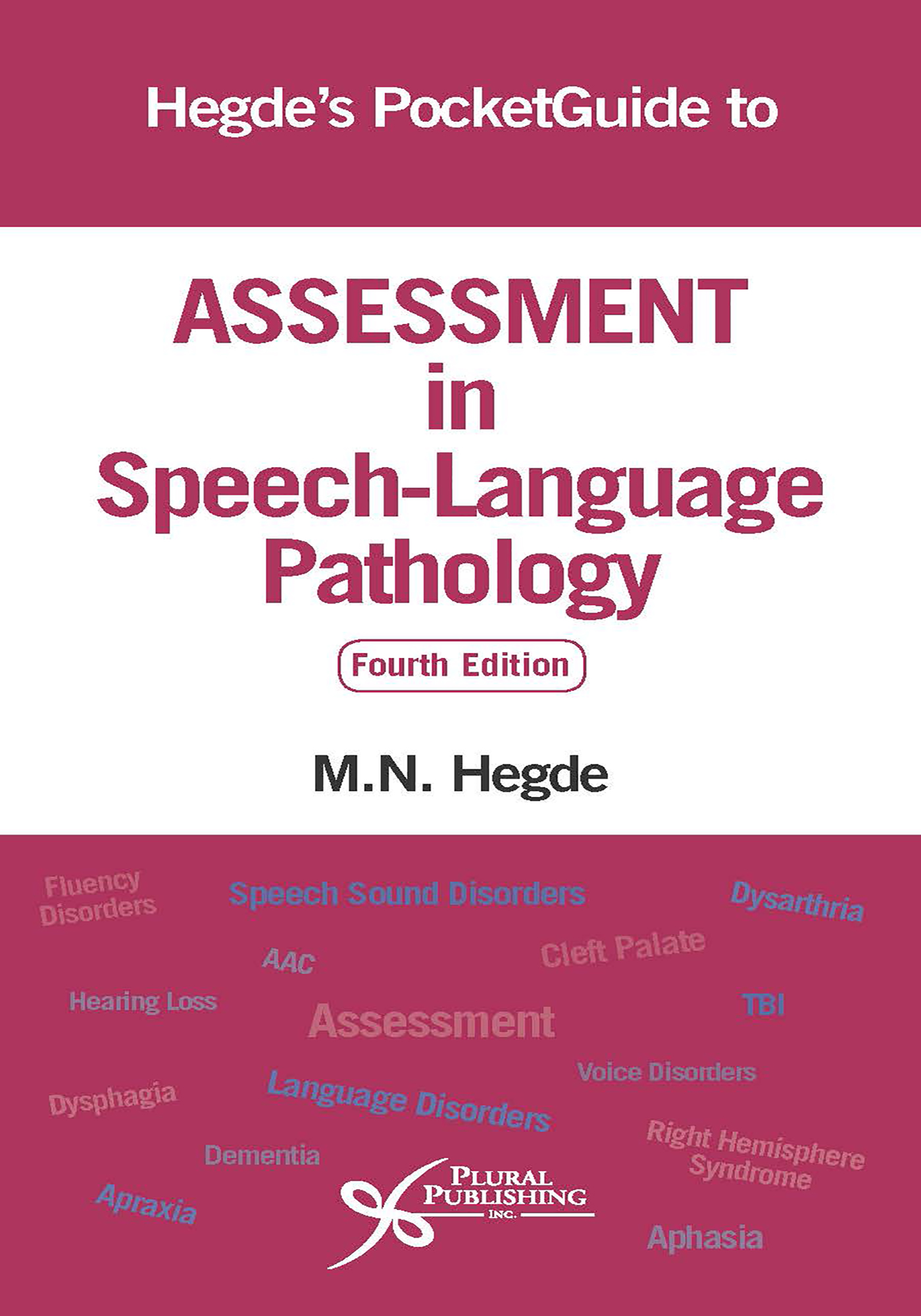
Hegde's PocketGuide to Assessment in Speech-Language Pathology.
Fourth Edition
M.N. Hegde
Details: 562 pages, 2-Color, Softcover, 4.5" x 8"
ISBN13: 978-1-94488-310-2
© 2018 | Available
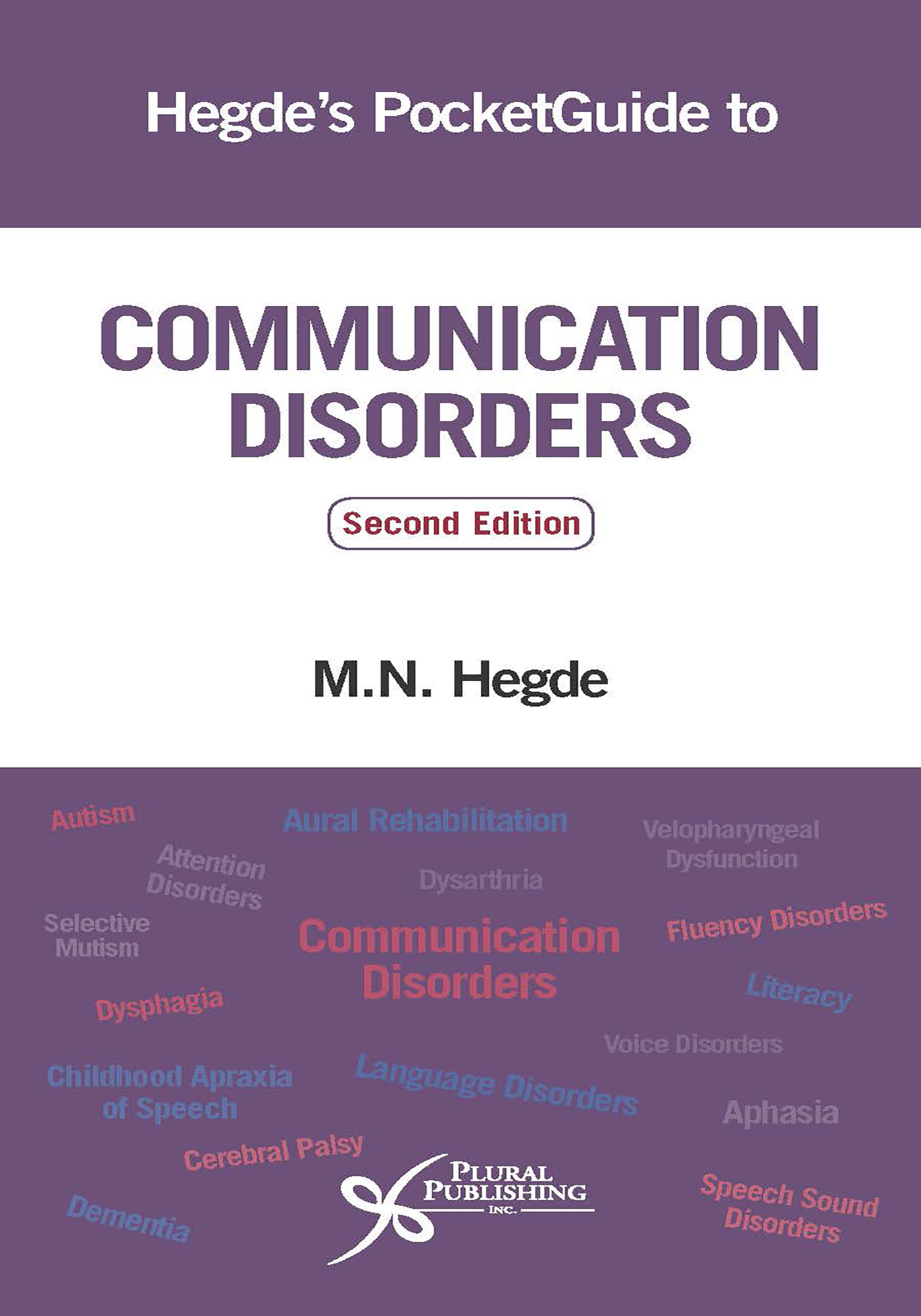
Hegde's PocketGuide to Communication Disorders
Second Edition
M.N. Hegde
Details: 496 pages, 2-Color, Softcover, 4.5" x 8"
ISBN13: 978-1-94488-314-0
© 2018 | Available
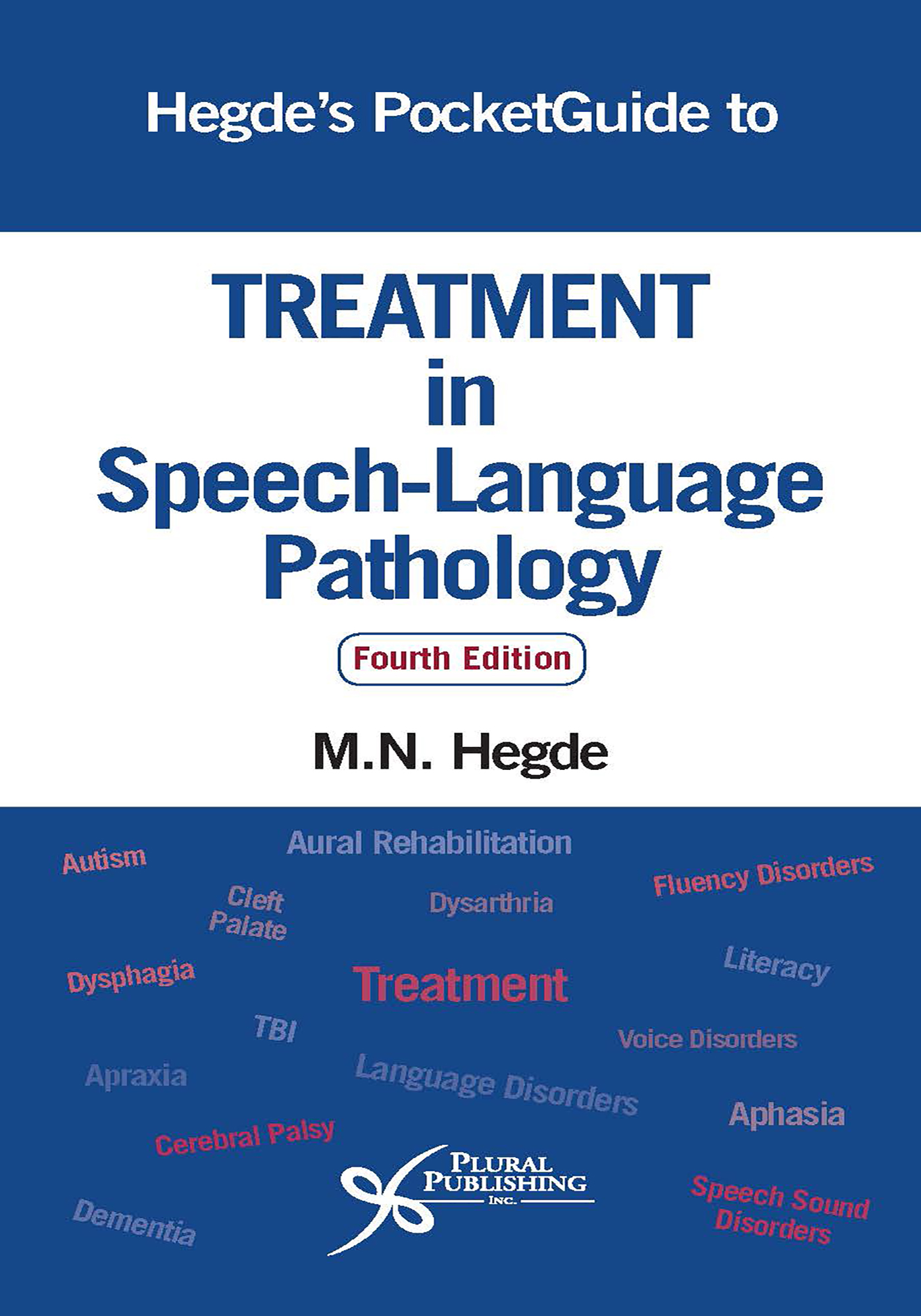
Hegde's PocketGuide to Treatment in Speech-Language Pathology.
Fourth Edition
M.N. Hegde
Details: 612 pages, 2-Color, Softcover, 4.5" x 8"
ISBN13: 978-1-94488-312-6
© 2018 | Available

A Coursebook on Scientific and Professional Writing for Speech-Language Pathology
Sixth Edition
M.N. Hegde
Details: 459 pages, B&W, Spiral, 8.5" x 11"
ISBN13: 978-1-63550-401-9
© 2024 | Available
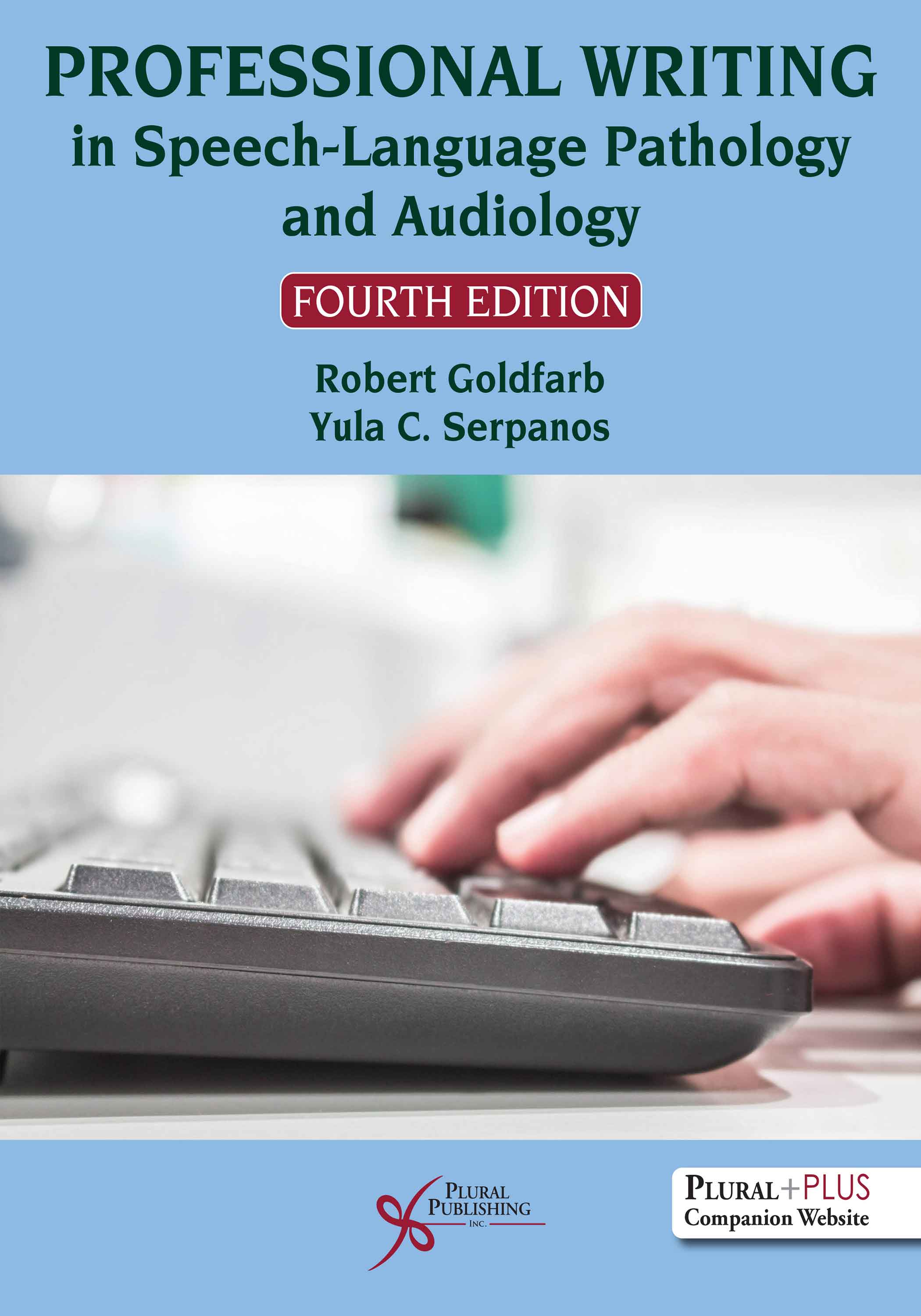
Professional Writing in Speech-Language Pathology and Audiology
Fourth Edition
Robert Goldfarb, Yula C. Serpanos
Details: 393 pages, B&W, Softcover, 8.5" x 11"
ISBN13: 978-1-63550-701-0
© 2025 | Available
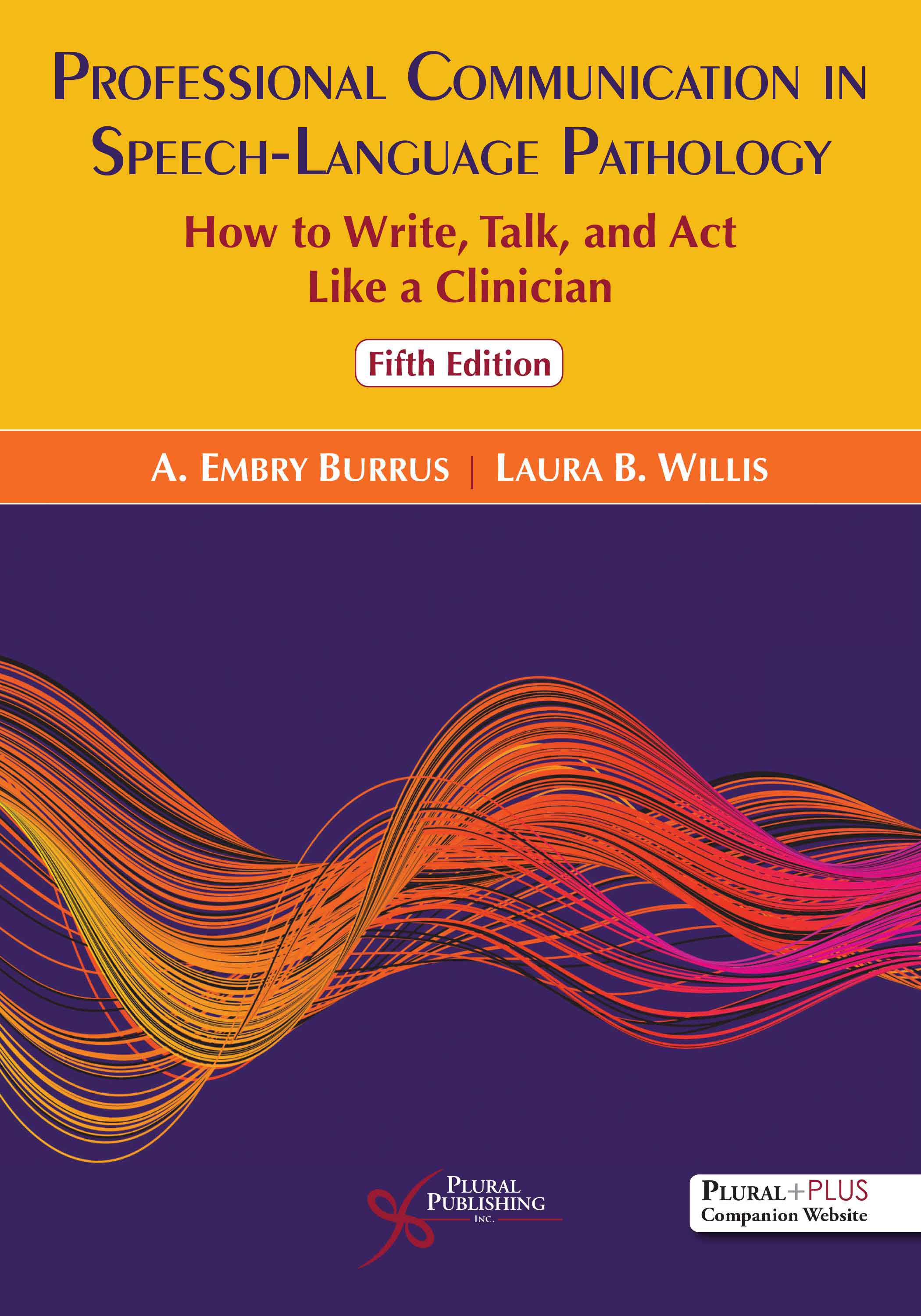
Professional Communication in Speech-Language Pathology: How to Write, Talk, and Act Like a Clinician
Fifth Edition
A. Embry Burrus, Laura B. Willis
Details: 280 pages, B&W, Softcover, 7" x 10"
ISBN13: 978-1-63550-658-7
© 2026 | Available
